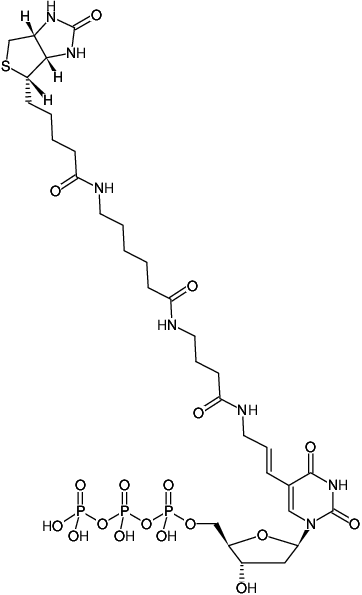Biotin-16-(5-aminoallyl)-dUTP
Biotinyl-ε-aminocaproyl-γ-aminobutyryl-5-(3-aminoallyl)-2'-deoxyuridine-5'-triphosphate, Triethylammonium salt
| Cat. No. | Amount | Price (EUR) | Buy / Note |
|---|---|---|---|
| NU-803-BIO16-S | 200 μl (1 mM) | 99,40 | Add to Basket/Quote Add to Notepad |
| NU-803-BIO16-L | 5 x 200 μl (1 mM) | 270,40 | Add to Basket/Quote Add to Notepad |

For general laboratory use.
Shipping: shipped on gel packs
Storage Conditions: store at -20 °C
Short term exposure (up to 1 week cumulative) to ambient temperature possible.
Shelf Life: 12 months after date of delivery
Molecular Formula: C32H52N7O18P3S (free acid)
Molecular Weight: 947.78 g/mol (free acid)
Exact Mass: 947.23 g/mol (free acid)
Purity: ≥ 98 % (HPLC)
Form: filtered solution (30 kDa) in water
Color: colorless to slightly yellow
Concentration: 1.0 mM - 1.1 mM
pH: 7.5 ±0.5
Spectroscopic Properties: λmax 240 nm, ε 10.7 L mmol-1 cm-1 (Tris-HCl pH 7.5)
Applications:
Incorporation into DNA/cDNA by
- PCR with Taq polymerase [1,2] & in-house data
- Nick Translation with DNAse I/ DNA Polymerase I [3,4] & in-house data
- Primer Extension with Klenow exo- [2,5]
- 3’-End Labeling with Terminal deoxynucleotidyl Transferase (TdT) [6,7]
- Reverse Transcription with MMLV Reverse Transcriptase [8,9]
Incorporation into RNA by
- 3’-End Labeling with Terminal deoxynucleotidyl Transferase (TdT) [10]
Description:
Biotin-16-dUTP is enzymatically incorporated into DNA/cDNA as substitute for its natural counterpart dTTP. The resulting Biotin-labeled DNA/cDNA probes are subsequently detected using streptavidin conjugated with horseradish peroxidase (HRP), alkaline phosphatase (AP), a fluorescent dye or agarose/magnetic beads. Optimal substrate properties and thus labeling efficiency as well as an efficient detection of the Biotin moiety is ensured by a 16-atom linker attached to the C5 position of uridine.
Recommended Biotin-16-dUTP/dTTP ratio for PCR and Nick Translation: 50% Biotin-16-dUTP/ 50% dTTP
Please note: The optimal final concentration of Biotin-16-dUTP may very depending on the application and assay conditions. For optimal product yields and high incorporation rates an individual optimization of the Biotin-16-dUTP/dTTP ratio is recommended.
Related products:
BIOZ Product Citations:
Selected References:
[1] Anderson et al. (2005) Incorporation of reporter-labeled nucleotides by DNA polymerases. Biotechniques 38:257.
[2] Cross et al. (1990) The structure of a subterminal repeated sequence present on many human chromosomes.Nucleic Acids Res. 18:6649.
[3] Langer et al. (1981) Enzymatic synthesis of biotin-labeled polynucleotides: novel nucleic acid affinity probes. Proc. Natl. Sci. USA 78:6633.
[4] Brigati et al. (1983) Detection of viral genomes in cultured cells and para nembedded tissue sections using biotin-labeled hybridization probes. Virology 12632.
[5] Perry et al. (2007) Diet and the evolution of human amylase gene copy number variation. Nat Genet 39:1256.
[6] Gorczyca et al. (1993) Detection of DNA strand breaks in individual apoptotic cells by the in situ terminal deoxynucleotidyl tranferase and nick translation assays. Caner Res 63:1954.
[7] Bassell et al. (1994) Single mRNAs visualized by ultrastructural in situ hybridization are principally localized at actin lament intersections in fibroblasts. J Cell Biol 126:863.
[8] Yih et al. (2002) Changes in gene expression profiles of human fibroblasts in response to sodium arsenite treatment. Carcinogenesis 23:867.
[9] Luo et al. (2003) Designing, testing, and validating a focused stem cell microarray for characterization of neutral stem cells and progenitor cells. Stem Cells 21:575.
[10] Rosemeyer et al. (1995) Nonradioactive 3'-End Labeling of RNA molecules of different length by Terminal Deoxynucleotidyltransferase. Analytical Biochemistry 224:446.